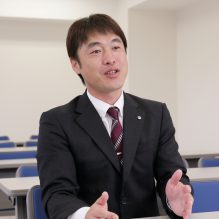-
About
- Kyoto Prize
-
Research Grants
-
Social Contributions
- Events
- News
This website uses cookies to improve the user experience. If you continue on this website, you will provide your consent to our use of cookies.
About
Research Grants
Social Contributions

Associate Professor, Faculty of Education, Hokkaido University *Profile is at the time of the award.
2021Inamori Research GrantsBiology & Life sciences
I would like to open up a new area of research in sports history and to make it one of the models for research in the humanities.
In Olympic Games held before the Second World War, Japanese Olympians won a total of 13 medals in track and field events. The details of these victories have been extensively studied, with researchers using memoirs, records of personal experiences, and newspaper articles. However, little is known about the motions or performance the athletes exhibited, including what these motions or performance signified. The reason is that sport history is yet to establish a method for analyzing video footage for insights into athletes’ motions or performance.
Thus, this study aimed to clarify the running or jumping motions by which Japanese Olympians won medals at track and field events in prewar Olympic Games. Two analyses were conducted. The first concerned the running motions of Kinue Hitomi, who won Silver in the women’s 800 meters at Amsterdam 1928. The second concerned the jumping motions of Chūhei Nambu, who won Gold in the men’s triple jump (known at the time as the “hop, step, and jump”) at Los Angeles 1932. The methods were twofold. First, I found video footage of the Olympians and analyzed the context of the footage. Second, I analyzed the athletic motions captured in the footage. For this analysis, I used a biomechanics approach and referred to historical literary sources.
The results were as follows. Results 1: From among footage from a Japanese film library, private collections, from TV broadcasts, and an online streaming site, I obtained 11 pieces of footage showing Kinue Hitomi running the 800 meters at Amsterdam 1928, and six pieces of footage showing Chūhei Nambu performing the triple jump at Los Angeles 1932.
Contextual analysis of the footage of Kinue Hitomi revealed the following: the footage of women’s 800 meters was recorded on two cameras, with four camera locations and six camera angles. Contextual analysis of the footage of Chūhei Nambu revealed the following: the footage of men’s triple jump was recorded from four locations, and Nambu attempted five triple jumps. The footage of Nambu winning Gold was ambiguous, so I collated the footage with historical sources, enabling me to identify a convincing piece of footage of Nambu winning Gold and setting a world record.
Results 2: I analyzed Hitomi’s running motions or performance (elbow and knee height) using Dartfish Pro S, a software program that can analyze athletic motions in video footage. For comparison, I conducted the same analysis on the running motions or performance of the athlete who won the race in question: Lina Radke (1903–1983). The comparison revealed that, whereas Radke moved her arms and legs slower in the second lap than she did in the first, Hitomi improved her arm and leg movement as the race progressed. Regarding running motions, Hitomi exhibited a wide arm swing matched with a long stride. This style would have made it easier to receive power from the ground. Regarding running speed, the Dartfish Pro S analysis revealed that Radke ran 18% slower, while Hitomi ran 3% faster, in the second lap compared to the first. Thus, the wide arm swing identified in the running analysis may have helped Hitomi to accelerate in the home straight of the race. However, in both analyses (Hitomi and Radke), software limitations meant that the analysis failed to cover 88% of running motions and 69% of running speed. Nonetheless, the analysis proved successful in recreating the women’s 800 meters event at Amsterdam 1928.
For Nambu, I used Dartfish Pro S to measure and analyze the distance and height Nambu traveled in his jump. The distance may have been erroneous depending on camera angle, but the analysis suggested the hop was 4.02 meters, the step 5.03 meters, and the jump 6.67 meters. For elevation, I measured height displacement in center of gravity across a time series beginning from the runup and ending in the final landing. I also referred to comments Nambu made to the press. The results indicated that Nambu achieved his world record distance by shortening his runup, which had the effect of stabilizing his body. I also measured horizontal velocity of feet on a time series from hop takeoff to final landing. This analysis revealed that the horizontal velocity peaked at the step phase, with velocity rising again during the final jump. The results suggest that, in Nambu’s record-breaking triple jump, he shortened his runup to stabilize his upper body, enabling him to maximize efficiency (minimize loss of energy) at the step phase, such that his motion during his final jump lengthened the distance of the jump.
Sakita Y and Kondo Y (2022), The case study of Chuhei Nambu’s triple jump through an analysis of the documentary film of the Ⅹth Olympiad. Hokkaido journal of physical education, health and sport sciences 57, 31-38.
Kondo Y, Sakita Y and Kimura K (2024 ). An examination of the Women’s 800m Athletics Race at the Ⅸ th Olympiad with documentary film. The Japan journal of sport history 37 ( in press).
Biology & Life sciences
